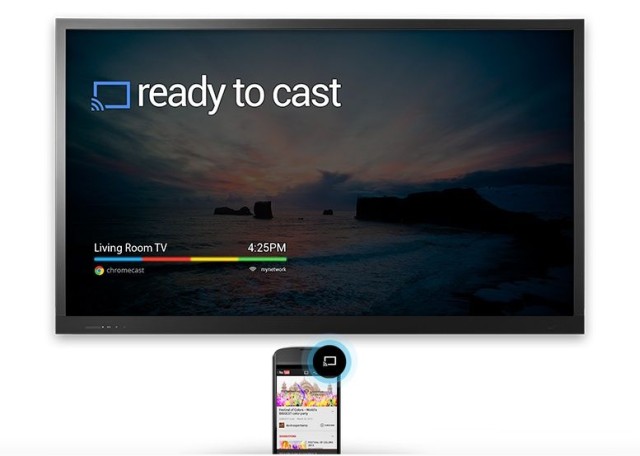With Chromecast, Google Makes Cross-Platform Power Play To Own Your TV
Google’s secret weapon in the TV wars could hardly be more simple: It’s an inexpensive little dongle called Chromecast that’s designed to change the way you watch TV.
Chromecast does that by turning almost any smartphone, tablet or PC into a remote control on steroids. Rather than limiting its audience to those with Android devices, Google hopes to lure customers to Chromecast by working across multiple platforms. The 2-inch dongle plugs into your HDTV and allows users to send videos from iPhones, Androids or laptops via WiFi to almost any TV with an HDMI port, giving users powers similar to Apple’s AirPlay — except it plays nice with strangers.
It’s ridiculously simple. And at only $35, it’s cheap as hell, which is precisely why Google thinks it’s the perfect device to take over your living room.
Google faces plenty of competition in the war to own your TV experience, and the battlefield is littered with would-be conquerors (including Google’s own fatally flawed Nexus Q). Apple won’t reveal its plans for reinventing the television set, but with Chromecast, Google is going after TV the same way it dominated search, maps and smartphones — by making something powerful and easy to use, then giving it away.
The shiny new dongle isn’t technically free, but when you include the three months of Netflix thrown in for early adopters (a $24 value, even for current Netflix subscribers), Chromecast basically costs $11, so yeah — pretty much free. Compare Chromecast’s price to the Apple TV at $99, or even the super-cheap Roku LT at $49, and it’s a steal for every consumer in America who wants to watch streaming video on their HDTV. Practically any smartphone, tablet or computer can instantly become a remote media control center with Chromecast, and you don’t have to buy into an entire ecosystem like you do with Apple TV.
It’s a pretty ingenious plan, really. Who wouldn’t throw away 11 bucks to see what the future of TV might look like? Why not buy one for every big screen in your house? Apparently, that’s how a lot of gadget geeks felt today: Chromecast sold out almost instantly on the Google Play store, and Amazon is temporarily out of stock as of this writing.
The incredibly low price point and cross-platform powers aren’t the only attraction, though. The Netflix and YouTube apps shown off at today’s Google press event in San Francisco look plenty powerful, but we’ve only seen a glimpse of the defining feature of Chromecast — Chrome tab projection, which gives Chromecast the ability to become almost anything. Yes, you can watch YouTube videos on your TV, stream House of Cards from Netflix, or jam out to Morris Day and the Time on your TV speakers through Pandora, but with Chrome tab projection, your TV will morph into new experiences that haven’t been dreamed up yet.
The list of content partners was pretty slim during today’s unveiling, but Chrome tab projection opens up the platform to an infinite amount of content that’s already available in your web browser. You can project Hulu, HBO Go and Rdio to your TV right from the get-go without developers having to do any extra work.
Everything about Chromecast sounds great, but it’s not without limitations. You must keep it plugged in, either to the included power supply or a USB port. App selection is limited at launch. You can’t stream native video or audio to your TV. There’s no mirroring for games. There’s also the fact that Google has already crashed and burned with Google TV.
But once developers dive into the Google Cast SDK, we can expect a slew of new apps and ways to consume content. If you only have an Apple TV, you’ll be forced to wait for Apple to add it to the platform, and that highlights the big difference between the two companies: Apple creates an entire experience for you, managing all the details, while Google allows you to create your own experience.
Apple TV users are always conscious that they are interacting with Apple’s little black box, whereas Chromecast is something you never see. There’s no extra interface to mess with on your TV. You just find content on your phone and push it over to your TV to see all the granular details, and according to Wired’s Joe Brown, everyone will want to see the details.
Chromecast is basically a tiny trojan horse designed to give Google a foothold on the biggest screen in your house. It looks slick and easy to use, and it’s creating the kind of buzz that’s been missing lately from Apple’s product offerings. Let’s just hope this thing works.



